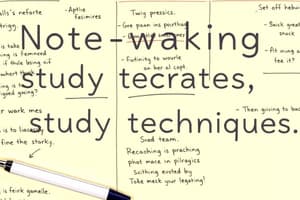Podcast
Questions and Answers
What should be prioritized in effective note-taking?
What should be prioritized in effective note-taking?
- Use of long paragraphs
- Artistic presentation
- Clarity and brevity (correct)
- Lengthy explanations
Which method is recommended for organizing information in notes?
Which method is recommended for organizing information in notes?
- Random sequences
- Freeform paragraphs
- Chronological order
- Bullet points or numbered lists (correct)
What is a suggested technique for enhancing efficiency in note-taking?
What is a suggested technique for enhancing efficiency in note-taking?
- Using complete sentences only
- Using abbreviations and symbols (correct)
- Copying verbatim from sources
- Prioritizing aesthetic appeal
During the note-taking process, it is important to...
During the note-taking process, it is important to...
How should headers be formatted in notes?
How should headers be formatted in notes?
Which of the following contributes to the review and revision of notes?
Which of the following contributes to the review and revision of notes?
What is a benefit of using visual aids in note-taking?
What is a benefit of using visual aids in note-taking?
Why is it important to maintain consistency in formatting during note-taking?
Why is it important to maintain consistency in formatting during note-taking?
What should be considered when developing a customized note-taking system?
What should be considered when developing a customized note-taking system?
Which option reflects a characteristic of effective notes?
Which option reflects a characteristic of effective notes?
Flashcards
Structured note-taking
Structured note-taking
A note-taking style that emphasizes precision, structure, and clarity. It utilizes a system of headings, subheadings, bullets, and lists to organize information logically.
Active note-taking
Active note-taking
The process of engaging with material while taking notes, identifying key themes, extracting essential information, and summarizing complex ideas. It involves active listening, critical thinking, and effective note-taking techniques.
Note-taking shorthand
Note-taking shorthand
Using abbreviations, symbols, and shorthand to efficiently capture information during note-taking. This practice saves time and space while maintaining clarity.
Note-taking structure
Note-taking structure
Signup and view all the flashcards
Connecting new information
Connecting new information
Signup and view all the flashcards
Note review and revision
Note review and revision
Signup and view all the flashcards
Visual note-taking
Visual note-taking
Signup and view all the flashcards
Color-coding notes
Color-coding notes
Signup and view all the flashcards
Customized note-taking
Customized note-taking
Signup and view all the flashcards
Multiple note-taking methods
Multiple note-taking methods
Signup and view all the flashcards
Study Notes
Note-Taking Guidelines
- Maintain a concise and structured format for notes.
- Prioritize clarity and brevity in your notes.
- Use bullet points or numbered lists to organize information.
- Focus on key facts and concepts, avoiding extraneous details.
- Employ markdown formatting for readability.
- Limit headers to ### and below, maintaining a clear hierarchy.
- Present information factually, avoiding opinions or interpretations.
- Ensure each point is self-contained and understandable independently.
Note-Taking Structure Example
- Design a structure that aids review and comprehension.
- Organize information logically, using subheadings for different sections.
- Employ bullet points to list key ideas and details concisely.
- Ensure each bullet point provides complete and independent information.
Note-Taking Process
- Actively engage with the material while taking notes.
- Identify key themes and concepts within the subject matter.
- Extract the essential information from the source.
- Summarize complex ideas into concise and understandable points.
- Utilize abbreviations and symbols for efficiency and conciseness.
- Maintain an organized format to facilitate review.
- Include all necessary information to fully understand the topic.
- Employ clear and concise language for easy comprehension.
- Concentrate on the core points without unnecessary detail.
- Ensure all sections of your notes are interconnected and related.
Note-Taking Tips
- Use abbreviations and symbols effectively for efficiency.
- Maintain consistency in formatting throughout your notes.
- Regularly review and revise your notes after each session.
- Connect new information to existing knowledge for better retention.
- Incorporate visual aids like diagrams or charts for better understanding.
- Highlight or underline important concepts for emphasis.
- Develop a personalized note-taking system that works for you.
- Utilize various note-taking methods, experimenting to find what suits you best.
- Implement color-coding to categorize and group different topics visually.
- Ensure all sections of your notes are well-connected and make logical sense together.
Studying That Suits You
Use AI to generate personalized quizzes and flashcards to suit your learning preferences.




